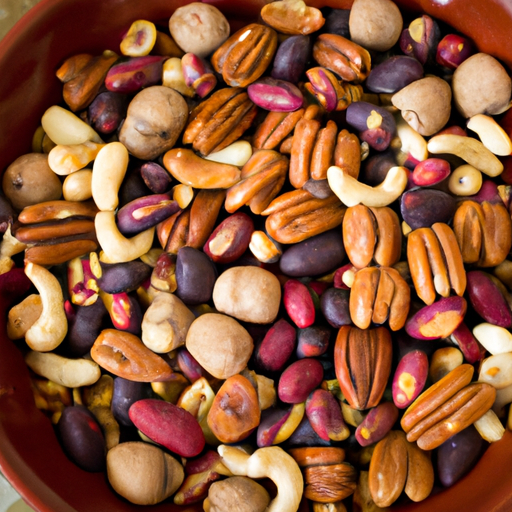If you’re a baking enthusiast looking to add a twist of nutty goodness to your recipes, look no further! In this article, we will guide you through the art of baking with nuts, sharing expert tips and techniques to enhance the flavors and textures of your treats. From selecting the right nuts for each recipe to incorporating them seamlessly into your doughs and batters, get ready to elevate your baking game and wow your taste buds with the nutty wonders that await. So grab your apron, preheat your oven, and let’s get baking with nuts!

Choosing the Right Nuts
When it comes to choosing the right nuts for your recipes, it’s important to consider the flavor and texture they will bring to your dish. Different nuts have distinct flavor profiles that can enhance the overall taste of your baked goods. Some nuts, like almonds and walnuts, have a slightly sweet and buttery flavor, while others, like cashews and pistachios, have a more savory and rich taste.
Consider the recipe
Before you start baking, take a moment to consider the recipe you’ll be using. Does it call for a specific type of nut or leave it open for interpretation? Pay attention to the flavor combinations in the recipe, as certain nuts may complement the other ingredients better than others. For example, if you’re making a chocolate chip cookie, you might opt for walnuts or pecans to add a contrasting crunch and nutty flavor.
Understanding flavor profiles
To better understand the flavor profiles of different nuts, it’s a good idea to experiment with tasting them individually. This will help you identify the unique characteristics of each nut and determine which ones will work best for your recipes. You can also consult online resources or cookbooks that provide a guide to the flavors of various nuts.
Experimenting with different nuts
Don’t be afraid to get creative and try different nuts in your recipes. Mixing and matching different nuts can create interesting flavor combinations and add variety to your baked goods. You can experiment with toasted nuts for a deeper, nuttier flavor or use a blend of nuts to create a unique and complex taste. The possibilities are endless, so let your palate guide you in choosing the right nuts for your baking endeavors.
Prepping the Nuts
Once you’ve chosen the right nuts for your recipe, it’s important to properly prepare them before incorporating them into your baked goods. This involves deciding whether to use raw or roasted nuts, removing any skins or shells, and determining whether to chop them or leave them whole.
Raw or roasted nuts?
Deciding between raw or roasted nuts largely depends on the flavor and texture you want to achieve in your baked goods. Raw nuts have a lighter, more natural flavor and can provide a pleasant crunch when used whole or roughly chopped. Roasted nuts, on the other hand, have a deeper, richer flavor due to the caramelization process that occurs during roasting. They can add a toasty and slightly sweet taste to your recipes. Consider the recipe and personal preference when making this decision.
Removing skins and shells
Some nuts, such as almonds and hazelnuts, come with skins that can be bitter and affect the overall taste of your baked goods. It’s often recommended to remove these skins by blanching or toasting the nuts and rubbing them with a clean cloth to loosen the skins. Similarly, if you’re using nuts with shells, like peanuts or pistachios, you’ll need to remove the shells before incorporating them into your recipes.
Chopping or leaving whole
The size of the nuts in your baked goods can greatly impact the texture and overall eating experience. If you prefer a more uniform distribution of nuts, consider chopping them into smaller pieces. This works well for cookies, bars, and cakes where you want the nuts to be evenly dispersed throughout the batter. On the other hand, leaving the nuts whole can provide a satisfying crunch and visual appeal. This is particularly true for decorative garnishes or when using nuts as a topping. Consider the desired texture and appearance when deciding whether to chop or leave the nuts whole.

Enhancing Nutty Flavor
Nuts already bring a delicious nutty flavor to your recipes, but there are some extra steps you can take to enhance that flavor even further. Toasting nuts, using nut oils, and infusing nuts with additional flavors can all contribute to a more intense and irresistible nuttiness in your baked goods.
Toasting nuts
Toasting nuts is a simple yet effective way to bring out their natural oils and intensify their flavor. It can be done in a dry pan on the stovetop or in the oven. Whichever method you choose, make sure to keep a close eye on the nuts as they can go from perfectly toasted to burnt in a matter of seconds. Once toasted, let the nuts cool before incorporating them into your recipes. Toasted nuts can add depth and complexity to your baked goods, making them even more irresistible.
Using nut oils
Nut oils, such as almond oil or walnut oil, can be used to enhance the nutty flavor in your recipes. These oils are extracted from the nuts and can provide a concentrated burst of nuttiness. They can be used in place of regular cooking oil or butter to add additional flavor to your baked goods. However, keep in mind that nut oils have a strong flavor, so a little goes a long way. Be sure to adjust the quantities accordingly to prevent overpowering the other flavors in your recipes.
Infusing nuts with flavor
If you’re feeling adventurous and want to take your nutty flavors to the next level, consider infusing your nuts with additional flavors. This can be done by coating the nuts in a mixture of spices, such as cinnamon or nutmeg, before toasting them. You can also experiment with sweet flavors by tossing the nuts in honey or maple syrup before roasting. The process of infusing nuts allows you to personalize the flavor profile and create unique taste sensations in your baked goods.
Substituting Nuts
In some cases, you may need to make substitutions when using nuts in your recipes. This could be due to allergies, dietary restrictions, or simply personal preference. Here are some considerations to keep in mind when substituting nuts in your baking endeavors.
Allergies and dietary restrictions
Nut allergies are common, and it’s important to be mindful of this when baking for yourself or others. Some people may have severe or life-threatening allergies to certain nuts, so it’s crucial to inquire about any dietary restrictions or allergies beforehand. If you or someone you’re baking for has a nut allergy, consider using seed-based alternatives like sunflower seeds or pumpkin seeds. Alternatively, you can opt for nut-free recipes that rely on other ingredients for flavor and texture.
Finding suitable alternatives
When substituting nuts, it’s important to choose alternatives that have a similar texture and flavor profile. For example, if a recipe calls for almonds, you could try using cashews or hazelnuts instead. Similarly, if you’re looking for a crunch similar to walnuts, you could experiment with pecans or macadamia nuts. Keep in mind that different nuts have varying levels of oiliness, so the final texture of your baked goods may be slightly different.
Creating your own nut mix
If you’re feeling adventurous and want to add your own twist to a recipe, consider creating your own nut mix. By combining different nuts and seeds, you can create a unique flavor profile and texture that suits your preferences. Experiment with different ratios and combinations until you find the perfect mix for your baked goods. This can be a fun and creative way to infuse your recipes with your own personal touch.

Understanding Nut Measurements
When it comes to nut measurements, there are a few considerations to keep in mind. This includes whether to measure by weight or volume, converting measurements, and considering the nut’s texture when determining quantities.
By weight or volume?
Measuring nuts by weight is generally more accurate than measuring by volume. However, if a recipe calls for nuts measured by volume, it’s important to pay attention to the instructions as different nuts can have different densities. For example, a cup of chopped walnuts may weigh more than a cup of whole almonds, even though they take up the same volume.
Converting measurements
If you come across a recipe that lists nut measurements in a different format than what you’re used to, it’s helpful to know how to convert between different units of measurement. For example, if a recipe calls for 100 grams of nuts and you prefer to use cups, you can use online conversion tools or baking references to determine the equivalent volume. Similarly, if a recipe calls for a cup of nuts but you only have whole nuts, you can measure the whole nuts and then chop them to get the desired volume.
Considering the nut texture
The texture of the nuts can also impact the measurements in your recipes. For example, finely ground nuts will pack more densely and occupy less volume compared to coarsely chopped nuts. Similarly, whole nuts will take up more space and may require additional chopping if you want a more uniform distribution in your baked goods. Consider the desired texture and appearance when determining the quantities of nuts in your recipes.
Adding Nuts to Different Baked Goods
Nuts can add a delightful texture and flavor to a variety of baked goods. From cakes and cupcakes to cookies and bars, and even breads and pastries, there are endless possibilities for incorporating nuts into your recipes.
Cakes and cupcakes
Adding nuts to cakes and cupcakes can create a delightful surprise in each bite. You can fold chopped nuts into the batter or sprinkle them on top as a decorative element. Consider using pecans or almonds for a classic touch, or experiment with more exotic options like macadamia nuts or pistachios for a unique twist. Nuts can add a satisfying crunch and depth of flavor to your cakes and cupcakes, making them even more enjoyable.
Cookies and bars
Nuts are a perfect addition to cookies and bars, providing a contrast in texture and flavor. You can add chopped nuts directly into the cookie dough or crust for extra crunch and nuttiness. Consider using walnuts or hazelnuts in your chocolate chip cookies for a wonderful combination of flavors. For bar cookies, nuts can be used in the crust or sprinkled on top as a decadent garnish. The options are limitless, so feel free to get creative and experiment with your favorite nuts in cookie and bar recipes.
Breads and pastries
Nuts can elevate the flavor and texture of breads and pastries, adding complexity and depth. Consider incorporating chopped nuts into your bread dough for a rustic touch, or use them as a topping to add a delightful crunch. You can also grind nuts into a powder and use them as a replacement for some of the flour in pastry recipes. This can result in a nutty and buttery flavor that complements the other ingredients beautifully. When it comes to breads and pastries, nuts can take your creations to a whole new level of deliciousness.
Maintaining Nut Freshness
Properly storing nuts is essential to maintain their freshness and prevent them from going bad. Here are some tips for storing nuts and extending their shelf life.
Proper nut storage
To keep your nuts fresh, it’s important to store them in a cool, dry place. Nuts are prone to absorbing odors from other foods, so it’s best to keep them in an airtight container to protect their flavor. You can also store them in the refrigerator or freezer to extend their shelf life. Before storing nuts, make sure they are completely dry to avoid mold or spoilage.
Extending shelf life
If you have a large quantity of nuts that you won’t be using right away, consider freezing them to extend their shelf life. Nuts can be frozen in airtight containers or freezer bags for several months. However, keep in mind that freezing can affect the texture of some nuts, so it’s best to use them in recipes where the texture is less of a concern, such as in baked goods.
Signs of spoiled nuts
It’s important to regularly check your nuts for signs of spoilage. Spoiled nuts may have a rancid or off-putting smell and taste. They may also appear discolored or have a slimy texture. If you notice any of these signs, it’s best to discard the nuts as they can ruin the taste of your recipes. Fresh, high-quality nuts will have a pleasing aroma and taste, making them a delightful addition to your baked goods.
Dealing with Nut Allergies
When baking with nuts, it’s important to be mindful of nut allergies and take steps to prevent cross-contamination. Here are some tips for handling nut allergies in your kitchen.
Understanding common allergies
Nut allergies are one of the most common food allergies and can range from mild to life-threatening. It’s important to educate yourself about the most common nuts that people are allergic to, such as peanuts, tree nuts (like almonds, walnuts, and cashews), and hazelnuts. This knowledge will help you make informed decisions when baking for others or accommodating your own dietary needs.
Preventing cross-contamination
Cross-contamination can occur when nut particles from one ingredient come into contact with another ingredient or surface, potentially causing an allergic reaction. To prevent cross-contamination, it’s important to thoroughly clean and sanitize your utensils, equipment, and work surfaces before and after working with nuts. It’s also a good idea to store nuts separately from other ingredients in airtight containers to minimize the risk of accidental exposure.
Labeling for allergy awareness
When baking for others, it’s considerate to label your baked goods to indicate whether nuts were used in the recipe. This helps individuals with allergies identify which treats are safe for them to consume. You can use labels or cards to clearly indicate that nuts are present, even if they are not a main ingredient but may be present due to cross-contamination. This extra step can help ensure the safety and enjoyment of your baked goods for everyone.
Nutty Presentation and Garnishes
In addition to adding flavor and texture to your baked goods, nuts can also be used to create beautiful and eye-catching presentations. Here are some ideas for using nuts as decorations and garnishes.
Decorating with whole nuts
Whole nuts can be used to create stunning decorative patterns on cakes, cupcakes, and other baked goods. You can arrange them in a spiral pattern, create a border around the edges, or create a centerpiece using a variety of nuts. Consider using different sizes and shapes of nuts to create visual interest and add a touch of elegance to your creations.
Using ground nuts as coatings
Ground nuts can be used as coatings for truffles, bonbons, or even as a replacement for breadcrumbs in savory dishes. Simply grind the nuts in a food processor or coffee grinder until they reach a fine consistency, and then use them to coat your treats. This adds a layer of flavor and texture, making your treats even more delightful.
Making nut brittle for toppings
Nut brittle is a delicious and crunchy topping that can be used to add both flavor and texture to your baked goods. You can make nut brittle by caramelizing sugar and mixing in your favorite nuts before allowing it to harden. Once cooled and solidified, break the brittle into small pieces and use it as a topping for cakes, cupcakes, ice cream, or any other dessert. The sweet and nutty combination will add a delightful surprise to every bite.
Nutty Recipes to Try
If you’re looking for some nutty inspiration, here are a few recipes to try out in your own kitchen.
Classic nutty brownies
Indulge your taste buds with a batch of classic nutty brownies. These rich and fudgy brownies are elevated with the addition of your favorite nuts, such as walnuts or pecans. The nuts provide a wonderful crunch and complement the chocolatey goodness of the brownies. They are perfect as an afternoon treat or a decadent dessert.
Almond shortbread cookies
For a delicate and buttery treat, try making almond shortbread cookies. The rich flavor of almonds is showcased in these tender and crumbly cookies. You can sprinkle them with sliced almonds for an elegant touch, or dip them in melted chocolate for an extra indulgence. These cookies are perfect for enjoying with a cup of tea or coffee.
Pecan pie with a twist
Put a twist on a classic dessert with a pecan pie that’s bursting with flavor. The sweet and nutty pecans are mixed with a rich caramel filling, all nestled in a flaky pie crust. You can add a hint of cinnamon or a drizzle of chocolate to take this pie to the next level. It’s the perfect dessert for any occasion and is sure to impress your friends and family.
Baking with nuts opens up a world of possibilities in the kitchen. From choosing the right nuts for your recipes to mastering different baking techniques, nuts can take your creations to new heights of deliciousness. So get creative, experiment with flavors and textures, and enjoy the nutty goodness that baking with nuts brings to your kitchen.

